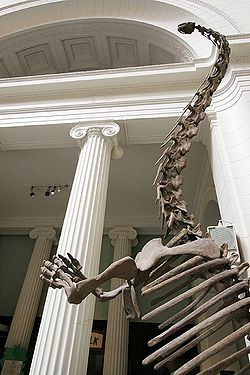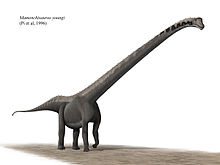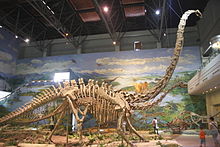- Mamenchisaurus
-
Mamenchisaurus
Temporal range: Late Jurassic, 160–145 Ma
Mounted M. hochuanensis skeleton, Field Museum Scientific classification Kingdom: Animalia Phylum: Chordata Class: Reptilia Superorder: Dinosauria Order: Saurischia Suborder: Sauropodomorpha Infraorder: Sauropoda Family: Mamenchisauridae Genus: Mamenchisaurus
Young, 1954Species Mamenchisaurus (
 /mɑːˈmʌntʃiˈsɔrəs/ mah-mun-chi-sawr-əs,[1] or spelling pronunciation /məˌmɛntʃiˈsɔrəs/) was a plant-eating four-legged dinosaur, known for its remarkably long neck [1] which made up half its total length.[2] It is known from numerous species which ranged in time from 160 to 145 million years ago, from the Oxfordian to Tithonian ages of the late Jurassic Period of China.
/mɑːˈmʌntʃiˈsɔrəs/ mah-mun-chi-sawr-əs,[1] or spelling pronunciation /məˌmɛntʃiˈsɔrəs/) was a plant-eating four-legged dinosaur, known for its remarkably long neck [1] which made up half its total length.[2] It is known from numerous species which ranged in time from 160 to 145 million years ago, from the Oxfordian to Tithonian ages of the late Jurassic Period of China.Contents
Discoveries
 Mounted M. hochuanensis skeleton, Field Museum
Mounted M. hochuanensis skeleton, Field Museum
Mamenchisaurus was first discovered in 1952 on the construction site of the Yitang Highway in Sichuan, China. The partial skeleton fossil was then studied, and named Mamenchisaurus constructus in 1954, by the renowned Chinese paleontologist Professor C. C. Young. The type specimen had an incomplete neck with 14 vertebra preserved and none of these were complete . M.constructus was estimated at 13 m (43 ft) long.[3]
In 1972, a second species of Mamenchisaurus was discovered (M. hochuanensis) with a neck that reached up to 9.3 m (31 ft) in length.[4] This species had a complete neck preserved which contained 19 vertebrae.[5] In 1994, the Sauroposeidon was discovered in the United States, with a neck estimated to be between 10.5 and 11.5 meters (34.5–37.5 feet) long, though its neck did not exceed that of the previously known Supersaurus, with a neck reaching 13–14 meters (42.5–46 feet).[6]
In 1993, M. sinocanadorum was described; this species possessed the longest cervical rib of any described sauropod dinosaur, measuring 4.1 m (13.5 ft). This is longer than the longest Sauroposeidon cervical rib, which measures 3.42 m (11.2 ft).[7]
In 2001, another M.hochuanensis specimen was described. It had skull, pectoral girdle and forelimb material preserved, all of which were missing from the holotype. It was also found with four fused tail vertebra, which have expanded neural arches and taller neural spines, that belong at the tip of the tail. It’s thought that these could be a weapon, such as a tail club, or a sensory organ. Other Chinese sauropods, Shunosaurus and Omeisaurus, are also known to have had ’tail clubs’ but they differ in shape to that of M.hochuanensis.[8][9]
Naming
Mamenchisaurus means 'Mamenchi lizard', from the Chinese Pinyin mǎ (马 'horse') and mén (门 'gate'), while chi is a transliteration of xī (溪 'stream' or 'brook'), combined with the suffix -saurus (from Greek sauros meaning 'lizard').
It was intended to name the reptile after the place where its fossil was first found — a construction site next to the Mǎmíngxī (马鸣溪) Ferry Crossing by the Jinsha River (金沙江, the westernmost major headwater stream of the Yangtze River), near Yibin (宜宾) in Sichuan Province of China. However, due to an accentual mix-up by Young, the location name Mǎmíngxī (马鸣溪 'horse-neighing brook') was mistaken as Mǎménxī (马门溪 'horse-gate brook').[10]
The fact that the first Mamenchisaurus fossil was found as the result of construction work led to Young's naming the type species as Mamenchisaurus constructus.[3]
Species
- M. anyuensis He, Yang, Cai, Li & Liu, 1996. Approximately 21 meters (69 ft) in length. Known from both the Suining Formation and Penglaizhen Formation.[11]
- M. constructus Young, 1954: (Type species) The holotype specimen, represented by a partial skeleton and was 13 ft (4.0 m) long.
- ?M. fuxiensis Hou, Zhao & Chu, 1976: Partial skeleton, include parts of a skull. It was originally named Zigongosaurus, and may be a different genus.
- M. hochuanensis Young & Zhao, 1972: Four partial skeletons. Known from Shaximiao Formation and 22 m (72 ft) in length.[5]
- M. jingyanensis Zhang, Li & Zeng, 1998. Known from Shaximiao Formation and estimated between 20 to 26 metres (66 to 85 ft) in length.[12]
- M. sinocanadorum D. Russell & Zheng, 1994: Partial skull, isolated bones. Known from the upper part of the Shishugou Formation (about 160 Ma ago), it may have been the largest, estimated up to 26 meters (85 ft) in length.[12][13]
- M. youngi Pi, Ouyang & Ye, 1996: Mamenchisaurus youngi (pronunciation YOUNG-eye) was unearthed in Xinmin County, Zigong City in Sichuan Province, China, in 1989.[14] The species was named in honour of Young. It was a very complete and articulated specimen presvering all the vertebra from the head up until the 8th tail vertebra. It had 18 neck vertebra. At 16 meters (52 ft) long with a 6.5-meter (21 ft) neck, is relatively small among various species of Mamenchisaurus.
References
- ^ Sues, Hans-Dieter (1997). "Sauropods". In James Orville Farlow and M. K. Brett-Surman (eds.). The Complete Dinosaur. Bloomington: Indiana University Press. pp. 274. ISBN 0-253-33349-0.
- ^ Norman, David B. (2004). "Dinosaur Systematics". In Weishampel, D.B., Dodson, P., and Osmólska, H. (eds.). The Dinosauria (2nd ed.). Berkeley: University of California Press. pp. 318. ISBN 0-520-24209-2.
- ^ a b Young, C.C. (1954), On a new sauropod from Yiping, Szechuan, China. sinica, III(4), 481-514.
- ^ Paul, G.S. (1988). "The brachiosaur giants of the Morrison and Tendaguru with a description of a new subgenus, Giraffatitan, and a comparison of the world's largest dinosaurs". Hunteria, 2(3): 1–14.
- ^ a b Young, C.C., and Zhao, X.-J. (1972). "Mamenchisaurus hochuanensis sp. nov." Institute of Vertebrate Paleontology and Paleoanthropology Monographs, A, 8:1-30.
- ^ Wedel, M.J., and Cifelli, R.L. (2005). "Sauroposeidon: Oklahoma’s native giant." Oklahoma Geology Notes, 65(2): 40-57.
- ^ "Osteology, paleobiology, and relationships of the sauropod dinosaur Sauroposeidon", by Mathew J. Wedel, Richard L. Cifelli, and R. Kent Sanders (Acta Palaeontologica Polonica 45, pages 343–388, 2000).
- ^ Ye, Y; Ouyang, H; Fu, Q-M. (2001). "'New material of Mamenchisaurus hochuanensis from Ziging China '". Vertrebrate Palasiatica 39 (4): 266–271.
- ^ Xing, L; Ye, Y; Shu, C; Peng, G; You, H (2009). "'Structure, orientation and finite element analysis of the tail club of Mamenchisaurus hochuanensis.'". Acta Geologica Sinica (English Edition) 83 (6): 1031–1040. doi:10.1111/j.1755-6724.2009.00134.x.
- ^ Origin of the Mamenchisaurus name (in Chinese), Beijing Museum of Natural History website
- ^ He, Xinlu; Yang, Suihua,; Cai,, Kaiji; Li,kui; Liu, Zongwen (1996). "A new species of sauropod, Mamenchisaurus anyuensis sp. nov." (PDF). Papers on Geosciences contributed to the 30th Geological Congress: 83–86. http://www.paleoglot.org/files/He&_96.pdf.
- ^ a b Zhang, Yihong; Li, kui; Zeng, Qinghua (1998). "'A new species of sauropod from the Late Jurassic of the Sichuan Basin (Mamenchisaurus jingyanensis sp. nov.)'". Journal of the Chengdu University of Technology 25 (1): 61–68.
- ^ Eberth, D.A., Xu, X. and Clark, J.M. (2010). "Dinosaur death pits from the Jurassic of China." Palaios, 25(2): 112-125.
- ^ Ouyang, H. and Ye, Y. 2002. The First Mamenchisaurian Skeleton with Complete Skull: Mamenchisaurus youngi (in Chinese with English summary). 111 pp + 20 plates. Sichuan Science and Technology Press, Chengdu.
External links
- Dinosaur.net.cn (in Chinese and English)
- Mamenchisaurus at DinoData
Categories:- Sauropods
- Jurassic dinosaurs
- Dinosaurs of Asia
Wikimedia Foundation. 2010.



